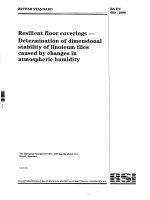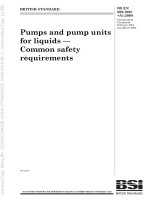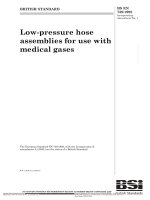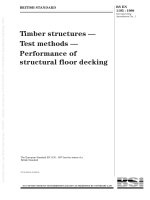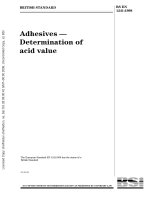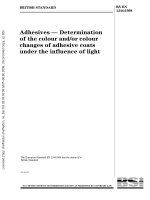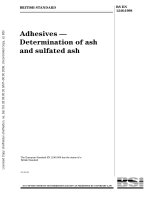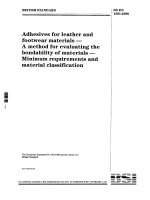Bsi bs en 61345 1998
Bạn đang xem bản rút gọn của tài liệu. Xem và tải ngay bản đầy đủ của tài liệu tại đây (249.78 KB, 10 trang )
BRITISH STANDARD
UV test for photovoltaic
(PV) modules
The European Standard EN 61345:1998 has the status of a
British Standard
ICS 27.160
BS EN
61345:1998
IEC 61345:
1998
BS EN 61345:1998
National foreword
This British Standard is the English language version of EN 61345:1998. It is
identical with IEC 61345:1998.
The UK participation in its preparation was entrusted to Technical Committee
GEL/82, Solar photovoltaic energy systems, which has the responsibility to:
— aid enquirers to understand the text;
— present to the responsible international/European committee any
enquiries on the interpretation, or proposals for change, and keep the UK
interests informed;
— monitor related international and European developments and
promulgate them in the UK.
A list of organizations represented on this committee can be obtained on
request to its secretary.
From 1 January 1997, all IEC publications have the number 60000 added to
the old number. For instance, IEC 27-1 has been renumbered as IEC 60027-1.
For a period of time during the change over from one numbering system to the
other, publications may contain identifiers from both systems.
Cross-references
Attention is drawn to the fact that CEN and CENELEC Standards normally
include an annex which lists normative references to international
publications with their corresponding European publications. The British
Standards which implement international or European publications referred
to in this document may be found in the BSI Standards Catalogue under the
section entitled “International Standards Correspondence Index”, or by using
the “Find” facility of the BSI Standards Electronic Catalogue.
A British Standard does not purport to include all the necessary provisions of
a contract. Users of British Standards are responsible for their correct
application.
Compliance with a British Standard does not of itself confer immunity
from legal obligations.
Summary of pages
This document comprises a front cover, an inside front cover, pages i and ii,
the EN title page, pages 2 to 4, an inside back cover and a back cover.
This standard has been updated (see copyright date) and may have had
amendments incorporated. This will be indicated in the amendment table on
the inside front cover.
This British Standard, having
been prepared under the
direction of the Electrotechnical
Sector Board, was published
under the authority of the
Standards Board and comes
into effect on
15 August 1998
© BSI 05-1999
ISBN 0 580 30248 2
Amendments issued since publication
Amd. No.
Date
Comments
BS EN 61345:1998
Contents
National foreword
Foreword
Text of EN 61345
© BSI 05-1999
Page
Inside front cover
2
3
i
ii
blank
EN 61345
EUROPEAN STANDARD
NORME EUROPÉENNE
EUROPÄISCHE NORM
April 1998
ICS 27.160
English version
UV test for photovoltaic (PV) modules
(IEC 61345:1998)
Essai aux rayons ultra-violets des
modules photovoltaïques (PV)
(CEI 61345:1998)
Prüfung von photovoltaischen (PV)
Modulen mit ultravioletter (UV)-Strahlung
(IEC 61345:1998)
This European Standard was approved by CENELEC on 1998-04-01.
CENELEC members are bound to comply with the CEN/CENELEC Internal
Regulations which stipulate the conditions for giving this European Standard
the status of a national standard without any alteration.
Up-to-date lists and bibliographical references concerning such national
standards may be obtained on application to the Central Secretariat or to any
CENELEC member.
This European Standard exists in three official versions (English, French,
German). A version in any other language made by translation under the
responsibility of a CENELEC member into its own language and notified to the
Central Secretariat has the same status as the official versions.
CENELEC members are the national electrotechnical committees of Austria,
Belgium, Czech Republic, Denmark, Finland, France, Germany, Greece,
Iceland, Ireland, Italy, Luxembourg, Netherlands, Norway, Portugal, Spain,
Sweden, Switzerland and United Kingdom.
CENELEC
European Committee for Electrotechnical Standardization
Comité Européen de Normalisation Electrotechnique
Europäisches Komitee für Elektrotechnische Normung
Central Secretariat: rue de Stassart 35, B-1050 Brussels
© 1998 CENELEC — All rights of exploitation in any form and by any means reserved worldwide for
CENELEC members.
Ref. No. EN 61345:1998 E
EN 61345:1998
Foreword
Contents
The text of document 82/187/FDIS, future edition 1
of IEC 61345, prepared by IEC TC 82, Solar
photovoltaic energy systems, was submitted to the
IEC-CENELEC parallel vote and was approved by
CENELEC as EN 61345 on 1998-04-01.
The following dates were fixed:
— latest date by which the
EN has to be implemented
at national level by
publication of an identical
national standard or by
endorsement
(dop) 1999-01-01
— latest date by which the
national standards
conflicting with the EN
have to be withdrawn
(dow) 2001-01-01
Foreword
2
1
Scope and object
3
2
Normative references
3
3
Initial measurements
3
4
Apparatus
3
5
Procedure
3
6
Final measurements
4
7
Requirements
4
Annex A (informative) Suggested
UV light sources
Inside back cover
Annex ZA (normative) Normative
references to international
publications with their
corresponding European
publications
Inside back cover
Annexes designated “normative” are part of the
body of the standard.
Annexes designated “informative” are given for
information only.
In this standard, Annex ZA is normative and
Annex A is informative.
Annex ZA has been added by CENELEC.
Endorsement notice
The text of the International Standard
IEC 61345:1998 was approved by CENELEC as a
European Standard without any modification.
2
© BSI 05-1999
EN 61345:1998
1 Scope and obj ect
4 Apparatus
This International Standard defines a test which
determines the resistance of the module when
exposed to ultra-violet (UV) radiation. This test is
useful for evaluating the UV resistance of materials
such as polymers and protective coatings.
The object of this test is to determine the ability of
the module to withstand exposure to ultra-violet
(UV) radiation from 280 nm to 400 nm. Before
conducting this test, light soaking or other
pre-conditioning should be performed in accordance
with IEC 61215 or IEC 61646.
The apparatus consists of the items listed below.
a) A temperature controlled test chamber or other
arrangement with a window or fixtures for a UV
light source and the module(s) under test. The
chamber shall be capable of maintaining the
module temperature at 60 °C ± 5 °C and a dry
condition.
b) A UV light source capable of producing UV
radiation with an irradiance uniformity
of ± 15 % over the test plane of the module(s) and
capable of providing the necessary total
irradiance in the different spectral regions of
2 Normative references
interest as defined in clause 5 c). The final test
report shall indicate which UV light source is
The following normative documents contain
used.
provisions which, through reference in this text,
constitute provisions of this International Standard.
c) Means for measuring and recording the
At the time of publication, the editions indicated
temperature of the module(s) to an accuracy
were valid. All normative documents are subject to
of ± 2 °C. The temperature sensors shall be
revision, and parties to agreements based on this
attached to the front or back surface of the
International Standard are encouraged to
module near the middle. If more than one module
investigate the possibility of applying the most
is tested simultaneously, it will suffice to monitor
recent editions of the normative documents
the temperature of one representative sample.
indicated below. Members of IEC and ISO maintain
d) A calibrated radiometer capable of measuring
registers of currently valid International Standards.
the irradiance of the UV light produced by the UV
IEC 60904-1:1987, Photovoltaic devices —
light source at the test plane of the module(s).
Part 1 : Measurements of photovoltaic
See Annex A for suggested UV light sources.
current-voltage characteristics.
IEC 60904-3:1989, Photovoltaic devices —
Part 3: Measurement principles for terrestrial
photovoltaic (PV) solar devices with reference
spectral irradiance data.
IEC 61215:1993, Crystalline silicon terrestrial
photovoltaic (PV) modules — Design qualification
and type approval.
IEC 61646:1996, Thin-film terrestrial photovoltaic
(PV) modules — Design qualification and type
approval.
3 Initial measurements
The following initial measurements shall be carried
out:
— visual inspection in accordance with
IEC 61215 or IEC 61646;
— I-V characteristics at standard test conditions
(STC) in accordance with IEC 60904-1;
— insulation test in accordance with IEC 61215
or IEC 61646.
© BSI 05-1999
5 Procedure
The test shall be carried out according to the
procedure outlined below.
a) Use the calibrated radiometer to measure the
irradiance at the proposed module test plane and
ensure that, at wavelengths between 280 nm
and 400 nm, the test spectral irradiance is never
more than 5 times the corresponding standard
spectral irradiance specified in the standard
AM 1,5 solar irradiance distribution given
by Table 1 of IEC 60904-3, that there is no
appreciable irradiance at wavelengths
below 280 nm and that it has a uniformity
of ± 15 % over the test plane.
b) Mount the module in the test plane at the
location selected in a) with the front side normal
to the UV irradiance beam.
c) While maintaining the module temperature
within the prescribed range, subject the
module(s) to a minimum irradiance of
— 7,5 kWh·m–2 in the wavelength range
between 280 nm and 320 nm, and
— 15 kWh·m–2 in the wavelength range
between 320 nm and 400 nm.
3
EN 61345:1998
d) Reorient the module so that the back side is
normal to the UV irradiance beam.
e) Repeat step c) for 10 % of the time at the
irradiation levels that were performed on the
front side.
6 Final measurements
Repeat the following tests:
— visual inspection in accordance with
IEC 61215 or IEC 61646;
— I-V characteristics at STC in accordance with
IEC 60904-1;
— insulation test in accordance with IEC 61215
or IEC 61646.
4
7 Requirements
The photovoltaic modules tested shall fulfill the
requirements stated below.
— No evidence of major visual defects, as defined
in IEC 61215 or IEC 61646.
— The degradation of maximum power output at
STC shall not exceed 5 % of the value measured
before the test. For thin-film modules, the
maximum output power at STC shall exceed the
manufacturer’s minimum power rating for this
module type.
— Insulation resistance shall meet the same
requirements as for the initial measurements, as
defined in IEC 61215 or IEC 61646.
© BSI 05-1999
EN 61345:1998
Annex A (informative)
Suggested UV light sources
Selection of a UV light source is based on its ability to meet the spectral requirements of this standard. The
following UV light sources can be able to meet these requirements when properly mounted and/or filtered.
A.1 QUV-A and QUV-B fluorescent UV lamps, or similar
QUV-B lamps have a spectral range from 280 nm to 315 nm. The only drawback with this light source is
the fact that almost all of the irradiance will be at the high energy end of the specified irradiance range. A
combination of QUV-B and QUV-A fluorescent lamps may be used to provide the required irradiation in
the specified ranges.
A.2 Filtered xenon
The spectral irradiance of a filtered xenon lamp in the UV-visible range most closely resembles the
spectrum of natural sunlight, especially in the wavelengths from 280 nm to 320 nm. Because xenon
reproduces all of the solar spectrum, it has more energy in the wavelength bracket ranging from 320 nm
to 400 nm than the test specifies. To achieve a total irradiation of 7,5 kWh·m–2 between 280 nm
and 320 nm with a xenon source, the sample may be exposed to considerably more than the 15 kWh·m–2 of
total irradiation specified for the wavelength range between 280 nm and 400 nm.
A.3 UV-high pressure metal halide lamp
These are high pressure mercury discharge lamps with metal halide additives which radiate mainly UVA
and UVB. Special quartz glass shall be used to absorb the UVC radiation. This is also important in order
to avoid the production of ozone.
A.4 Natural sunlight
Natural sunlight can be utilized with concentration. As with the xenon source, in order to achieve a total
irradiation of 7,5 kWh·m–2 between 280 nm and 320 nm, the sample may be exposed to considerably more
than the 15 kWh·m–2 of total irradiation specified for the wavelength range between 280 nm and 400 nm.
Annex ZA (normative)
Normative references to international publications with their corresponding
European publications
This European Standard incorporates by dated or undated reference, provisions from other publications.
These normative references are cited at the appropriate places in the text and the publications are listed
hereafter. For dated references, subsequent amendments to or revisions of any of these publications apply
to this European Standard only when incorporated in it by amendment or revision. For undated references
the latest edition of the publication referred to applies (including amendments).
NOTE When an international publication has been modified by common modifications, indicated by (mod), the relevant EN/HD
applies.
Publication
Year
IEC 60904-3
1989
IEC 61215
1993
IEC 61646
1996
IEC 60904-1
© BSI 05-1999
1987
Title
Photovoltaic devices
Part 1: Measurement of photovoltaic current-voltage
characteristics
Part 3: Measurement principles for terrestrial
photovoltaic (PV) solar devices with reference
spectral irradiance data
Crystalline silicon terrestrial photovoltaic (PV)
modules — Design qualification and type approval
Thin-film terrestrial photovoltaic (PV) modules —
Design qualification and type approval
EN/HD
Year
EN 60904-3
1993
EN 61215
1995
EN 61646
1997
EN 60904-1
1993
BS EN
61345:1998
IEC 61345:
1998
BSI — British Standards Institution
BSI is the independent national body responsible for preparing
British Standards. It presents the UK view on standards in Europe and at the
international level. It is incorporated by Royal Charter.
Revisions
British Standards are updated by amendment or revision. Users of
British Standards should make sure that they possess the latest amendments or
editions.
It is the constant aim of BSI to improve the quality of our products and services.
We would be grateful if anyone finding an inaccuracy or ambiguity while using
this British Standard would inform the Secretary of the technical committee
responsible, the identity of which can be found on the inside front cover.
Tel: 020 8996 9000. Fax: 020 8996 7400.
BSI offers members an individual updating service called PLUS which ensures
that subscribers automatically receive the latest editions of standards.
Buying standards
Orders for all BSI, international and foreign standards publications should be
addressed to Customer Services. Tel: 020 8996 9001. Fax: 020 8996 7001.
In response to orders for international standards, it is BSI policy to supply the
BSI implementation of those that have been published as British Standards,
unless otherwise requested.
Information on standards
BSI provides a wide range of information on national, European and
international standards through its Library and its Technical Help to Exporters
Service. Various BSI electronic information services are also available which give
details on all its products and services. Contact the Information Centre.
Tel: 020 8996 7111. Fax: 020 8996 7048.
Subscribing members of BSI are kept up to date with standards developments
and receive substantial discounts on the purchase price of standards. For details
of these and other benefits contact Membership Administration.
Tel: 020 8996 7002. Fax: 020 8996 7001.
Copyright
Copyright subsists in all BSI publications. BSI also holds the copyright, in the
UK, of the publications of the international standardization bodies. Except as
permitted under the Copyright, Designs and Patents Act 1988 no extract may be
reproduced, stored in a retrieval system or transmitted in any form or by any
means – electronic, photocopying, recording or otherwise – without prior written
permission from BSI.
This does not preclude the free use, in the course of implementing the standard,
of necessary details such as symbols, and size, type or grade designations. If these
details are to be used for any other purpose than implementation then the prior
written permission of BSI must be obtained.
BSI
389 Chiswick High Road
London
W4 4AL
If permission is granted, the terms may include royalty payments or a licensing
agreement. Details and advice can be obtained from the Copyright Manager.
Tel: 020 8996 7070.
